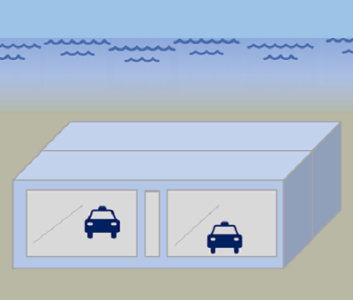Guldborgsund Tunnel
HEIGHT: 7.6 m
WIDTH: 20.6 m
TOTAL IMMERSED LENGTH: 460 m
DEPTH AT BOTTOM OF STRUCTURE: 13.8 m
FABRICATION METHOD: The two tunnel elements were cast one at a time in a drydock located in the future tunnel ramp at Lolland. The elements were cast in 15 m to 15.3 m segments to prevent cracks. When cracks occurred in the first segment, cooling was used in the second element, and no cracks were found.
WIDTH: 20.6 m
TOTAL IMMERSED LENGTH: 460 m
DEPTH AT BOTTOM OF STRUCTURE: 13.8 m
FABRICATION METHOD: The two tunnel elements were cast one at a time in a drydock located in the future tunnel ramp at Lolland. The elements were cast in 15 m to 15.3 m segments to prevent cracks. When cracks occurred in the first segment, cooling was used in the second element, and no cracks were found.
rossing the sound between the islands of Lolland and Falster,
Denmark

Road Directorate
Guldborg Sound Consortium: Armton A/S and Pihl & Son A/S
Christiani & Nielsen, Copenhagen
230m
460m
13.8m
Project construction
1988-04-30
2
Two tubes; each with two lanes
7.6m
20.6m
230 m long, vertically curved elements are some of the longest ever produced.
Computer-controlled dynamic ballasting was used.
Computer-controlled dynamic ballasting was used.
The two tunnel elements were cast one at a time in a
drydock located in the future tunnel ramp at Lolland. The
elements were cast in 15 m to 15.3 m segments to prevent
cracks. When cracks occurred in the first segment,
cooling was used in the second element, and no cracks
were found.
drydock located in the future tunnel ramp at Lolland. The
elements were cast in 15 m to 15.3 m segments to prevent
cracks. When cracks occurred in the first segment,
cooling was used in the second element, and no cracks
were found.
Each of the tunnel elements was provided with bulkheads at the ends and equipped
with six ballast tanks with a total capacity of 4,000 m³ of water. After flotation, the
elements were moved to their final position and sunk onto temporary supports
approximately 1 m above the bottom of the excavated trench.
with six ballast tanks with a total capacity of 4,000 m³ of water. After flotation, the
elements were moved to their final position and sunk onto temporary supports
approximately 1 m above the bottom of the excavated trench.
Between tunnel elements; Gina gasket supplemented with
flat rubber interior gasket. At shore ends of tunnel:
Temporary tightening by rubber lip gaskets, allowing
ramps to be emptied of water, whereupon the permanent
rubber Omega gaskets were installed between the tunnel
and the portal structures. The tunnel was made monolithic
by casting reinforced concrete in the temporary gap
between the two tunnel elements.
flat rubber interior gasket. At shore ends of tunnel:
Temporary tightening by rubber lip gaskets, allowing
ramps to be emptied of water, whereupon the permanent
rubber Omega gaskets were installed between the tunnel
and the portal structures. The tunnel was made monolithic
by casting reinforced concrete in the temporary gap
between the two tunnel elements.
The elements were waterproofed with a 6 mm steel membrane on the bottom and sides.
On the top, a bituminous membrane was installed and protected with 15 cm of
reinforced concrete.
On the top, a bituminous membrane was installed and protected with 15 cm of
reinforced concrete.
Sandjetting
The eastern part, where the tunnel is located above the seabed, is protected with 1 m of
gravel. No cover is provided for the remaining part of the tunnel.
gravel. No cover is provided for the remaining part of the tunnel.
Reinforced

